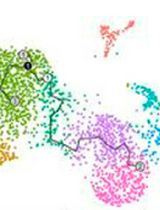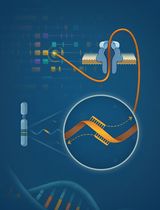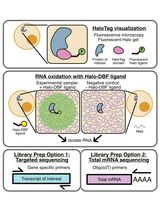- EN - English
- CN - 中文
Genome-wide Mapping of 5′-monophosphorylated Ends of Mammalian Nascent RNA Transcripts
哺乳动物新生 RNA 转录本 5′-单磷酸化末端的全基因组定位
发布: 2023年09月20日第13卷第18期 DOI: 10.21769/BioProtoc.4828 浏览次数: 1533
评审: Gal HaimovichMarion HoggRohini Ravindran Nair
Abstract
In eukaryotic cells, RNA biogenesis generally requires processing of the nascent transcript as it is being synthesized by RNA polymerase. These processing events include endonucleolytic cleavage, exonucleolytic trimming, and splicing of the growing nascent transcript. Endonucleolytic cleavage events that generate an exposed 5′-monophosphorylated (5′-PO4) end on the growing nascent transcript occur in the maturation of rRNAs, tRNAs, and mRNAs. These 5′-PO4 ends can be a target of further processing or be subjected to 5′-3′ exonucleolytic digestion that may result in termination of transcription. Here, we describe how to identify 5′-PO4 ends of intermediates in nascent RNA metabolism. We capture these species via metabolic labeling with bromouridine followed by immunoprecipitation and specific ligation of 5′-PO4 RNA ends with the 3′-hydroxyl group of a 5′ adaptor (5′-PO4 Bru-Seq) using RNA ligase I. These ligation events are localized at single nucleotide resolution via highthroughput sequencing, which identifies the position of 5′-PO4 groups precisely. This protocol successfully detects the 5′monophosphorylated ends of RNA processing intermediates during production of mature ribosomal, transfer, and micro RNAs. When combined with inhibition of the nuclear 5′-3′ exonuclease Xrn2, 5′-PO4 Bru-Seq maps the 5′ splice sites of debranched introns and mRNA and tRNA 3′ end processing sites cleaved by CPSF73 and RNaseZ, respectively.
Key features
• Metabolic labeling for brief periods with bromouridine focuses the analysis of 5′-PO4 RNA ends on the population of nascent transcripts that are actively transcribed.
• Detects 5′-PO4 RNA ends on nascent transcripts produced by all RNA polymerases.
• Detects 5′-PO4 RNA ends at single nucleotide resolution.
Background
Tracking genome-wide active transcription and its regulation has been made possible by several complementary approaches (Wissink et al., 2019). These include isolation of chromatin-associated RNAs (Bhatt et al., 2012, Mayer et al., 2015, Weber et al., 2014), RNA polymerase–associated RNAs (Churchman and Weissman, 2011, Nojima et al., 2015, Fong et al., 2017), or nascent transcripts pulse-labeled with nucleoside analogs such as 4-thiouridine (Schwalb et al., 2016, Kenzelmann et al., 2007, Rabani et al., 2011, Herzog et al., 2017, Muhar et al., 2018, Schofield et al., 2018), 5-ethenyluridine (Jao and Salic, 2008), or bromouridine (Paulsen et al., 2014).
In eukaryotic cells, endonucleolytic cleavage of the nascent transcript is used to release fully transcribed RNAs from chromatin or to release small RNAs from longer precursors during transcription [i.e., micro RNAs (miRNAs) and intron-encoded small nucleolar RNAs (snoRNAs)]. Most of these cleavage events are carried out by nucleases that leave 5′-phosphate (5′-PO4) and 3′ OH ends, including CPSF73, Int11, RNaseP, RNaseZ, and Drosha.
Recently, POINT-5 technology identified 5′ ends generated at cleavage sites of RNA pol II–associated transcripts from runoff products of 5′ RACE in reverse transcription reactions (Sousa-Luis et al., 2021), but this approach does not inform on the identity of the chemical group at these 5′ RNA ends. Previously, methods have been developed to specifically map 5′-PO4 RNA ends by virtue of their ability to be ligated to adaptors by RNA ligase I (Harigaya and Parker, 2012, German et al., 2008).
Here, we describe 5′-PO4 Bru-Seq for direct detection of 5′-PO4 groups in nascent transcripts produced by all RNA polymerases in the cell (Figure 1). The method was previously validated and used to identify targets of the Xrn2 exonuclease (Cortazar et al., 2022). In this method, total RNA is fragmented with Micrococcal Nuclease (MNase) that produces 5′ OH and 3′ PO4 ends, and nascent transcripts are enriched by immunoprecipitation of 5-bromouridine pulse-labeled molecules, followed by repair of 3′ phosphates with T4 polynucleotide kinase, ligation of 5′ and 3′ adaptors, and PCR amplification of sequencing libraries. Only RNA fragments with native 5′-PO4 ends can be incorporated into these libraries (Harigaya and Parker, 2012). Unique molecular identifiers (UMIs) are included to allow removal of PCR duplicates. The molecular events that result in 5′-PO4 groups on nascent RNA ends detected by this method potentially include cleavage by endonucleases, intron debranching, and decapping.

Figure 1. The 5′-PO4 Bru-Seq protocol. 5′-PO4 Bru-Seq enriches transcripts being extended by actively transcribing polymerases via metabolic labeling with bromouridine, fragmentation by micrococcal nuclease (MNase), and immunoprecipitation. The 3′-ends generated by MNase cleavage events are repaired by T4 polynucleotide kinase (PNK) in the absence of ATP. 5′-PO4 ends of nascent transcripts are then ligated to the 3′-hydroxyl group of a 5′ adaptor, amplified by PCR, and deep sequenced using Illumina sequencing technology.
Materials and reagents
Mammalian cell type of interest (e.g., HEK293, ATCC, catalog number: CRL-1573)
Cell culture media supplemented with 10% serum (e.g., DMEM supplemented with 10% FBS; DMEM, Thermo Fisher Scientific, catalog number: 11995040; FBS, VWR, catalog number: 97068-085)
10 cm tissue culture dishes (e.g., Genesee Scientific, catalog number: 25-200)
5/10 mL sterile serological pipets (e.g., Genesee Scientific, catalog numbers: 12-102, 12-104)
15/50 mL conical bottom centrifuge tubes (e.g., Corning, catalog numbers: 05-538-59A, 05-526B)
1.7 mL microcentrifuge tubes (e.g., Genesee Scientific, catalog number: 22-282)
TRIzol reagent (Thermo Fisher Scientific, catalog number: 15596018)
Chloroform (Fisher Scientific, catalog number: BP1145-1)
Isopropanol (Fisher Scientific, catalog number: BP2618-1)
80% ethanol, molecular biology grade (e.g., Thermo Fisher Scientific, catalog number: T08204K7)
GeneRuler 1 kb Plus DNA ladder (Thermo Fisher Scientific, catalog number: FERSM1333)
5 M NaCl, RNase-free (Thermo Fisher Scientific, catalog number: AM9760G)
Micrococcal nuclease (MNase) (2,000,000 gel units/mL) (New England Biolabs, catalog number: M0247S)
10× MNase reaction buffer (New England Biolabs, catalog number: B0247S)
0.5 M EGTA, pH 8.0, DNase and RNase Free (Thermo Fisher Scientific, catalog number: NC1874048)
Nuclease-free water (Thermo Fisher Scientific, catalog number: AM9939)
10× phosphate-buffered saline (PBS), pH 7.4, RNase-free (Thermo Fisher Scientific, catalog number: AM9624)
5-bromouridine (Sigma-Aldrich, catalog number: 850187)
Triton X-100 (Sigma-Aldrich, catalog number: X100)
1 M DTT (Thermo Fisher Scientific, Catalog number: P2325)
Superase-InTM RNase inhibitor (Invitrogen, AM2696)
Protein G magnetic beads (Pierce Thermo Scientific, catalog number: 88848)
Purified mouse anti-BrdU antibody (clone 3D4, RUO) (BD Pharmingen, catalog number: 555627)
QubitTM RNA High Sensitivity Assay kit (Thermo Fisher Scientific, catalog number: Q32852)
InvitrogenTM QubitTM assay tubes (Thermo Fisher Scientific, catalog number: Q32856)
T4 polynucleotide kinase (Thermo Fisher Scientific, catalog number: EK0031)
10× reaction buffer A (Thermo Fisher Scientific, catalog number: EK0031)
RNA Clean & ConcentratorTM-5 kit (ZYMO RESEARCH, catalog number: R1013, R1014)
QIAseq miRNA library kit (Qiagen, catalog number: 331502)
QIAseq miRNA Index kit IL UDI (e.g., UDI-B-96, Qiagen, catalog number: 331625)
10× TBE Buffer (Thermo Fisher Scientific, catalog number: AM9863)
1:20 dilution of MNase (100,000 gel units/mL) (see Recipes)
50 mM 5-bromouridine (see Recipes)
IP buffer (see Recipes)
Software
Removal of UMI duplicates: UMI-tools (Smith et al., 2017)
Removal of adaptor sequences: Cutadapt (Martin, 2011)
Genomic alignment of sequencing reads: Bowtie2 (Langmead and Salzberg, 2012)
BAM file processing: Samtools (Li et al., 2009)
Integrative Genomics Viewer (IGV) (Robinson et al., 2011)
Conversion of BAM files to BED files: bedtools (Quinlan and Hall, 2010)
Conversion of bedGraph files to BigWig: bedGraphToBigWig (Kent et al., 2010)
Equipment
1.5 mL microcentrifuge magnet stand (e.g., Thermo Fisher Scientific, catalog number: 12321D)
Centrifuge 5430 R (e.g., Eppendorf, catalog number: 022620601)
Thermal cycler (e.g., Bio-Rad, model: C1000 Touch, catalog number: 1851148)
Qubit fluorometer (Thermo Fisher Scientific, catalog number: Q33238)
Procedure
文章信息
版权信息
© 2023 The Author(s); This is an open access article under the CC BY-NC license (https://creativecommons.org/licenses/by-nc/4.0/).
如何引用
Cortázar, M. A., Fong, N. and Bentley, D. L. (2023). Genome-wide Mapping of 5′-monophosphorylated Ends of Mammalian Nascent RNA Transcripts. Bio-protocol 13(18): e4828. DOI: 10.21769/BioProtoc.4828.
分类
分子生物学 > RNA > RNA 测序
分子生物学 > RNA > RNA 合成
您对这篇实验方法有问题吗?
在此处发布您的问题,我们将邀请本文作者来回答。同时,我们会将您的问题发布到Bio-protocol Exchange,以便寻求社区成员的帮助。
提问指南
+ 问题描述
写下详细的问题描述,包括所有有助于他人回答您问题的信息(例如实验过程、条件和相关图像等)。
Share
Bluesky
X
Copy link













